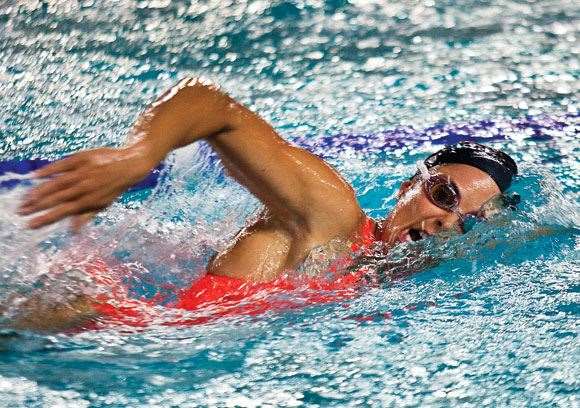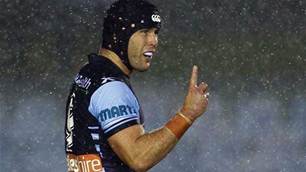“The races in the Kellogg’s Ironwoman Series are a lot shorter than in previous years, this year it’s all sprint".
 photos by Warren Clarke
photos by Warren Clarke“The races in the Kellogg’s Ironwoman Series are a lot shorter than in previous years, this year it’s all sprint".
Candice Falzon was just like any 11-year-old Maroubra nipper. Her little arms and legs would give her everything they could on comp days ... Except when it came to getting wet. “I’d just do the beach events – the sprints, the flags. I hated the water. I’d go in, but I’d scream, and I’d never finish the race. No one would ever pick me in their teams. I was shocking.”
But she was also competitive. “I actually missed the beach events at a local carnival we were heading to one day, but Dad said, ‘We’ve come all this way, the waves aren’t big, just go in on a board.’ So I did. I was so nervous, but I ended up finishing second. It did wonders for me as a kid. It made me think, ‘Hang on a second, I can do this.’”
No doubt that day was in the back of Falzon’s mind as she broke through for her first Kellogg’s Ironwoman event win at Coolum Beach last February. With that initial victory in the bag, there’ll be no stopping the 27-year-old as she attacks this summer’s six-stop campaign, which explodes into action in Perth on December 23 before continuing on to Newcastle, Portsea, Surfers, Coolum and Noosa.
Falzon uses events like the Rescue 2012 Life Saving World Championships to prepare for her Ironwoman campaigns. Indeed, she left Adelaide last month after scoring world titles (with team-mates) in the Ocean Women Relay and Open Female Rescue Tube Rescue. Here, she tells us how she’ll attack this year’s Kellogg’s series ... and what she’s learnt about about the water since her nipper days
HOW IT WORKS
“The races in the Kellogg’s Ironwoman Series are a lot shorter than in previous years. Last summer we had a few endurance events, but this year it’s all short, sharp sprinting stuff. All the races are going to be around 12-15 minutes long. There’ll be no room for error whatsoever; you make one mistake through the break and it’s going to cost you.
“Three out of the six rounds will be eliminators. Each eliminator is three races, with the last six competitors dropping out each time. It’s not like you can take it easy for the first race and save yourself for the last one. You have to make sure you’re getting through each time.
“There’ll also be an accumulator in Portsea, where you’ll compete in two or three races and earn points in each one. And then Coolum, where I won last year, will be made up of four races – one each of ski, board, swim, and then a full ironwoman race.”
DISCIPLINE
“All ironwoman races involve all four disciplines – run, swim, ski and board. But the order always changes. The exact distances change with the surf conditions, too. Officials might find themselves having to push the cans out a little bit further ... But it’s usually about a 150-200m run, 300m swim, 500m board paddle and 600m ski paddle. When you have the surf to contend with, and you’re going in and out of the break and you have to roll your 18kg ski and get back on, take a few strokes, then roll it again when another wave comes, it all becomes very tiring.”
WET, WET, WET
“The group I train with at Warringah Aquatic Centre is a very competitive surf squad. Our coach, Russell Subloo, has done a fantastic job with us. Last year there were so many Australian champions to come out of the squad. It’s a very successful group ‒ that’s why I travel from Maroubra to Warringah every morning to be a part of it. There are a lot of young kids who are always pushing to beat me, or for me to try and keep them on their toes. It’s important for when I train to have someone always pushing me, always trying to test the limits.
“On average, I’ll usually have four swimming training sessions a week – on Monday, Tuesday, Thursday and Friday. I like to have a sleep-in on the Wednesday morning, just to recover. We swim between 5am-7am and clock up anywhere between 5-7km.
“We’ll start with a 2km warm-up, which takes about half an hour, and is broken up into a little bit of medley work, some
kick, a lot of freestyle, just to loosen ourselves up for the main set, which is around 3-4km. If we’re doing an endurance set, it might be 8x400m swims on a short rest cycle, or we might do 10x200m sets at max effort, where we’re getting plenty of rest and recovery in between. We could do a set where we’ll go flat-out for 50m, and either walk or swim back for recovery. There might
also be sessions where we’ll do 30x100m, descending in time.”
“Fridays we do plyometrics to build up strength in our legs. This is all new to me, but I’ve found it to be very beneficial. It’s a lot of box jumps, stuff with sleds, medicine balls, little hurdles. It’s fun and something you can see improvements with. For example, you might put the box up a little bit higher each week and do more reps. My coach, Roger Fabri, is a renowned sprint trainer and has had a lot of success, so I feel I’m in good hands.
“Last season the run leg was really crucial in ironwoman because we were running longer distances. This year, the run legs are going to be a lot shorter. I began my career as a beach sprinter, so I know the importance of doing proper sprint training, and hopefully the hard work I’m doing with Roger will show.”
TO THE CORE
“I do gym on the days I’m not running, Tuesdays and Thursdays. I don’t do a lot of cardio stuff, just because so much of everything else I do is cardio-based. I do a lot of stability work, a lot of strength. Switching your core on in our sport is crucial. To be able to use your stomach when you’re running, when you’re paddling. Everything you do is about having a strong core.
“I’ll do exercises like three sets of chin-ups, I’ll throw ropes, do things like push-ups, where I’m balancing on a Swiss ball. I do things with cables, use Bulgarian bags, I’ll do kettle bells. If I do some squats or lunges, there’s always an added element; lunges I’ll do with kettle bells, squats I’ll do on a half-Swiss ball. I don’t necessarily do traditional things like bench presses or lift a lot of heavy weights.”
AT THE BEACH
“I train at the beach every day. Monday afternoons our squad is on the board. Tuesdays we’re on the surf ski. Wednesdays at 10.30am we’ll do a two-hour ironwoman session, where we’re just purely doing ironwoman simulation races. That’s probably one of the toughest sessions of the week. Thursday we’re back on the surf ski, Friday we do body surfing and again, we’ll go out on our boards. If we’re not racing on Saturday, we’ll do another iron session for two hours, and then Sunday we might do four board races, then four ski races.”
GETTING BOARD
“Now that we’ve hit summer, everything to do with the board is short, sharp ‒ working on our starts, finishes, little things like that which are really important. If you can attack the water and be the first one out through the break, more than likely you’ll set yourself up for a podium finish. We really have to know how to ride and catch waves, hold our board and ski, get back on quick and deal with different situations with the surf.”
SKILL SET
“The skill element of our sport is huge. You may be the best swimmer, you might be an Olympic "
“I do sprint training at Centennial Park in Sydney three times per week. Monday is a pure sprint session, where we focus on the front end of a race ‒ exploding off the blocks. That might involve some 30m sprints, then some 50s, working on the middle, and then we’ll do some 100m sprints. All the while, working on technique and being as efficient as we can.
“Wednesdays are a little bit harder. We might do anything from some 150m runs to agility work. It’s on shorter rests and pushes our lactate tolerance in our legs, which is important.
paddler, but if you come into the surf, and you don’t know how to read it, or catch waves or do those little things properly, you’re not going to win. A lot of people have crossed over and haven’t been successful. It’s important you know how to body surf – and try to outsurf the other competitors. It’s important you know how to get over waves on your board, to roll your board, roll your ski.”
 photos by Warren Clarke
photos by Warren ClarkeGONE-SKI
“On the ski we might do a set of ten two-minuters, five four-minuters, where we’ll go out to sea, then chase the runs back to the beach. You have an 18kg ski, and you also have a paddle in one hand. You only have one hand to roll your ski over and try to push through the wave in front of you and with the other hand you have to hang on to your paddle. These are all things we practise at training. My race win last year came down to me picking the right wave; coming in each time and picking up a wave that no one else did. That happened to me twice in that one race that I won. That comes down to practising my skills here and being able to assess certain situations.”
BODY SURFING 101
“It’s important that when the wave comes, you’re moving. You’re swimming, and all of a sudden you see this wave. You get down the wave, then you kick really hard to get on the wave. Once you’re on it, you want to keep your body stiff like a surfboard: head down as much as you can, hands straight out in front, arms straight, hands together. It’s important to keep your head down for as long as you can. As soon as you lift your head, it’s like putting a brake on. You’ve also got to kick with your legs the whole time. You need to keep up speed with the wave. If you’re just lying there, the wave is just going to go straight over your head.”
‒ James Smith
Related Articles

Barmy Army sledge Warner's wife

Training with the Cronulla Sharks' Michael Ennis













